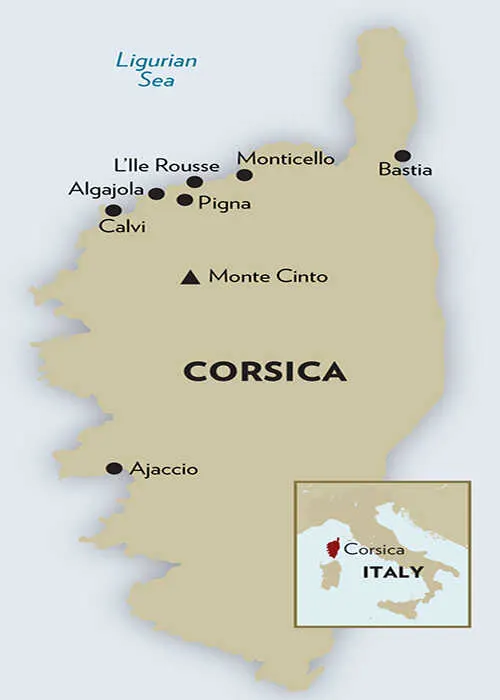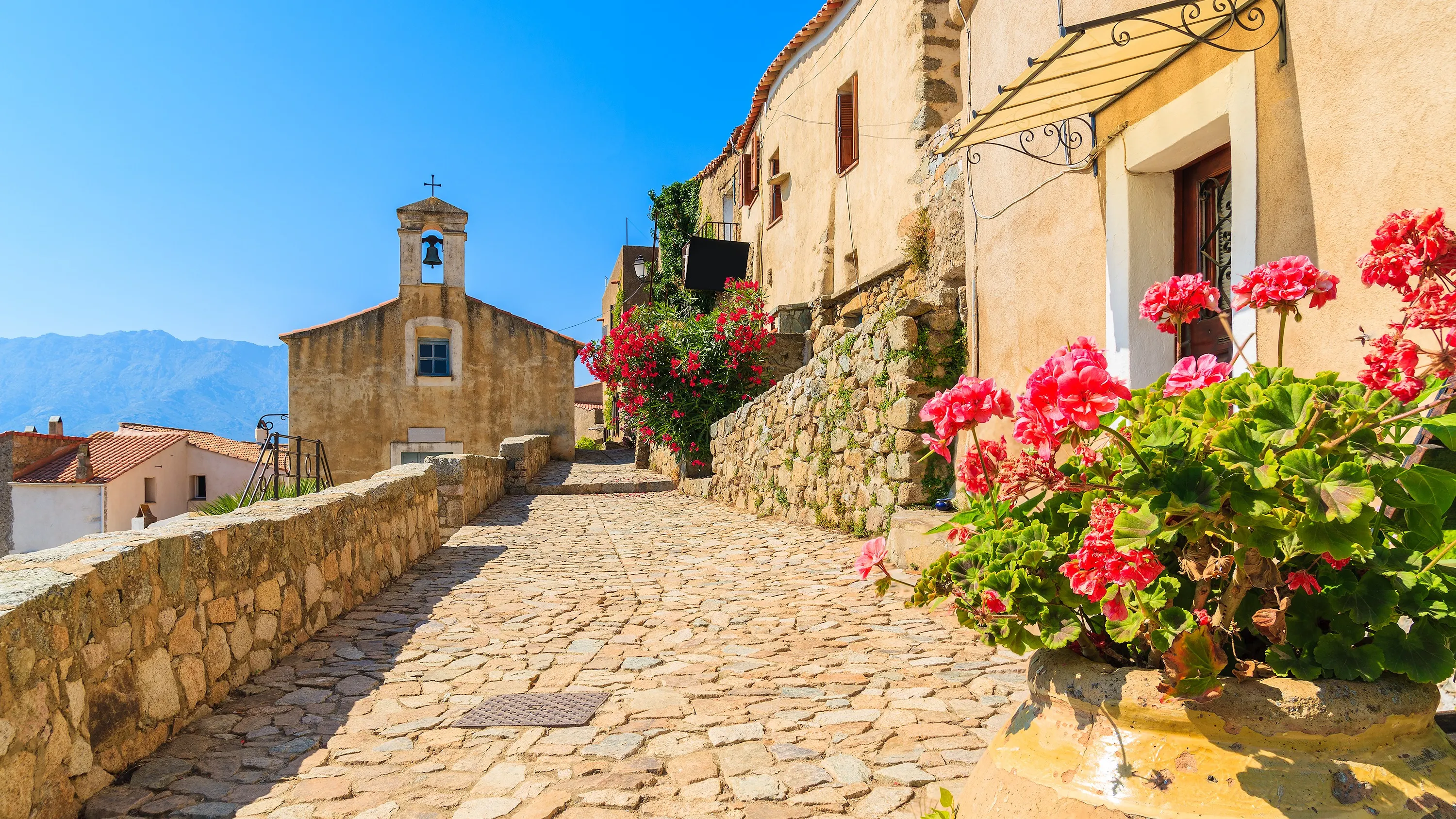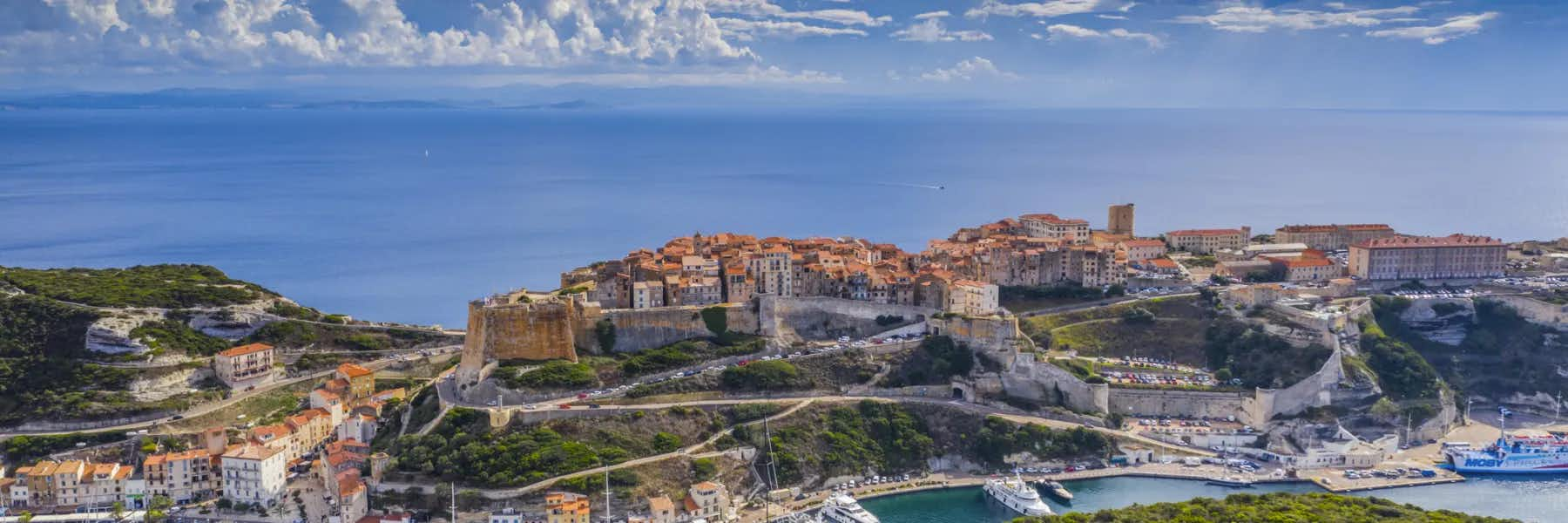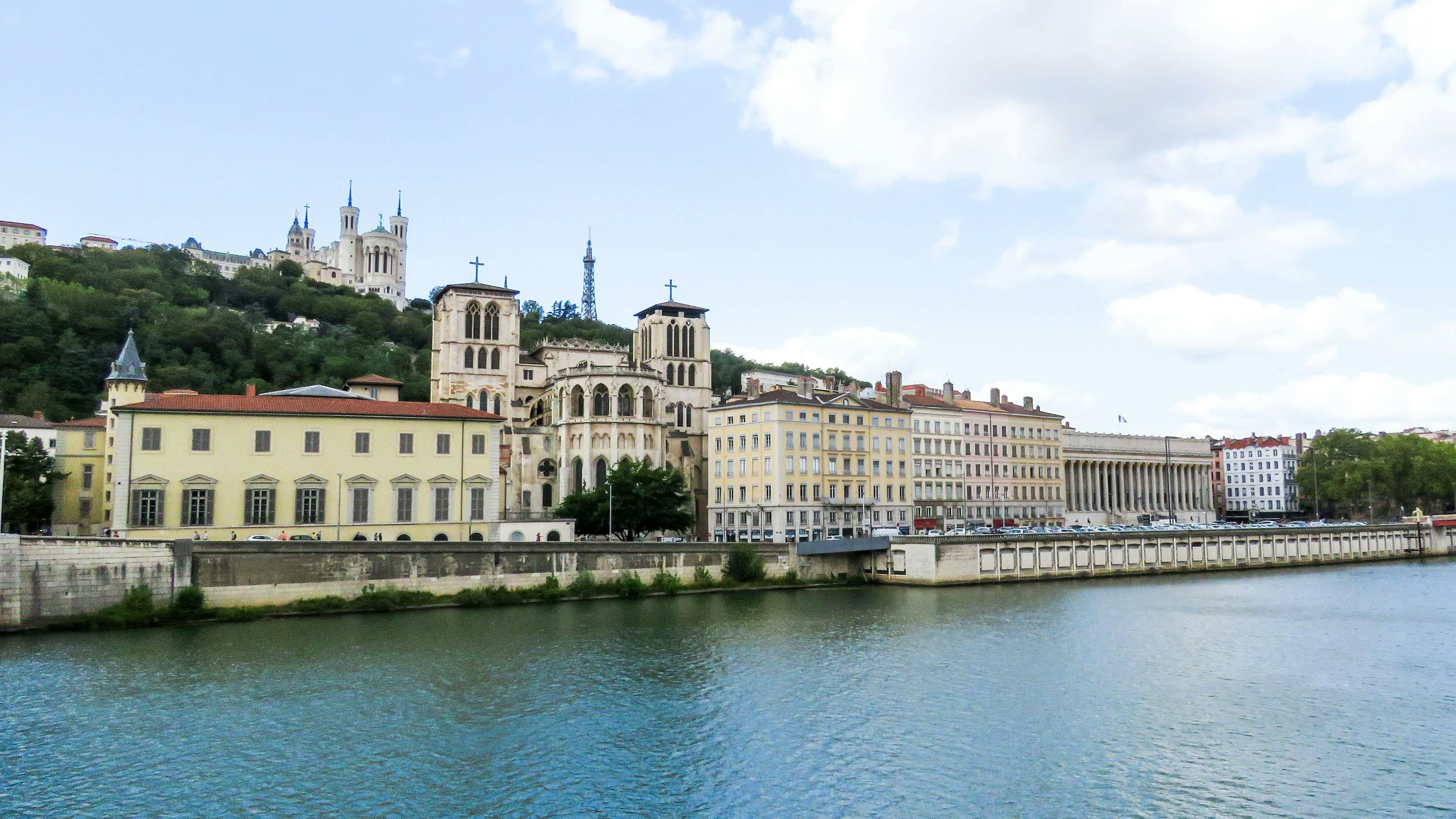Sometimes you can fall in love with a place, or at least the idea of it, without ever having set foot there. Pictures in your head, images or stories that travel across the miles, can grab you and never let you go. Finally, you’re compelled to experience their beauty for yourself; make your own memories, see if what you’ve been told is true.
Corsica had never meant a thing to me until I moved to France in 2010. At the time, I was getting out of a complicated love affair with the beautiful, and devilishly charming, peninsula known as Italy. Our up and down relationship had begun between the mahogany shelves of my local bookstore in my hometown of Ventura, California. Perched in a cozy armchair between stacks of novels, guidebooks, and memoirs, I was transported to a land of wispy sunflower fields, romantic hilltop villages, and mouthwatering cuisine.
Eventually, I decided it was time to discover my own Tuscan Sun and embarked on a three-month stay in Siena and Florence, closely followed by a full-blown move to Rome.
Although no one offered to help me renovate a crumbling Italian villa, nor did they whisk me away on a shiny Vespa to the Amalfi Coast, most of my expectations held true. As they did for my expat colleagues—an eclectic group of teachers working at an English language school near the Villa Borghèse in Rome.
One afternoon, Geneviève, a vivacious American expat with an excellent command of English grammar, threw us all for a loop. “We’re taking our honeymoon in Corsica,” she related, grinning from earto-ear in the manner of the newly engaged. “Steve and I are going to rent a motorbike and tour the island.”
Corsica? I was confused. I had no reference for the place, no stories to draw from or images to connect to the French island. I tried to picture the two of them careening down mountain roads mixed with gnarled bougainvillea and rocky, impregnable cliff faces dipping over the Mediterranean Sea. Or perhaps Corsica was an elegant collection of whitewashed, dome-capped villages like Santorini or Mykonos in Greece.
It was impossible to say, and frankly, I wasn’t fussed to learn more. We were, clearly, in one of the most beautiful countries in the world, with stunning island getaways like Ischia, Capri, and Sardinia right off the coast—familiar images we all knew and loved.
It was many more years before I thought about Corsica again. I’d picked up my own expat husband—there seemed to be an abundance of them in Rome— and moved to the southern French city of Toulon. There, it seemed like the Ile de Beauté (the Beautiful Island) was on everyone’s lips.
From our apartment balcony, we could see the passenger ferries departing for the Corsican ports of L’Ile Rousse, Ajaccio, and Bastia on a daily basis. “Everyone’s always raving about Corsica,” my husband, Nicolas, commented over dinner one evening, with about the same mixture of curiosity and apprehension that I felt. French news stories about the island veered between glowing documentaries to inflammatory opinion pieces on the fiercely independent, rebellious nature of its residents. It was hard to know what to believe.
Over the years, the air of mystery about the island grew, as did our desire to paint our own picture of Ile de Beauté. It wasn’t Italy, but it certainly had an interesting story to tell.
Get Your Free France Report Here
Get Your Free France Report Here
Learn more about France and other countries in our daily postcard e-letter. Simply enter your email address below and we’ll send you a FREE REPORT: A Taste of France: All the Ingredients for the Good Life.

By submitting your email address, you will receive a free subscription to IL Postcards and special offers from International Living and our affiliates. You can unsubscribe at any time, and we encourage you to read more about our Privacy Policy.
The Beautiful Island
Corsica has probably needed a good PR person since the 13th century, when it was governed by the Republic of Genoa, and was eventually ceded to France in 1768. Under Genoese rule, Corsicans waged a long, embittered, fight for independence. The transition to French authority was a hard pill to swallow. After several additional uprisings, and a brief intervention by British forces, the island was definitively annexed to the French Republic—a fact that is still a thorn in the side of many modern-day residents.
Famous for their fiercely proud, independent streak, Corsicans have retained their Italian traditions, while slowly integrating French cultural and administrative norms. Connection to the French Republic ushered in a higher standard of living for the island’s residents, and thus complicated further separatist movements as Corsicans profited from the mainland’s economic success.
The rise of her most famous son, Napoléon Bonaparte, went a long way in cementing the island’s influence on continental history, although it would take several decades before pockets of the territory achieved the affluence enjoyed in mainland France.
Modern-day Corsica lives under the duality of its shadowy, rebellious roots, and the promise of a flourishing travel and tourism industry. The island has an impressive number of natural resources packed into a compact, easily navigable space—including 620 miles of coastline and some of the most beautiful beaches in Europe.
Frequently cited as “a mountain in the sea,” Corsica is the most mountainous island in the Mediterranean, with a single, formidable, mountain range occupying two-thirds of its territory. The highest peak, Monte Cinto, tops out at 6,600 feet. Nearly half the island is classified as a natural park, including the Scandola Nature Reserve. A section of the G20, a fabled long-distance hiking trail, cuts through the island diagonally (from Calenzana to Conca), and takes roughly 16 days to complete.
Other popular activities include sailing, diving, and snorkeling, as well as swimming in the rock pools formed by the island’s rivers.
Although less developed than its Mediterranean neighbors, Corsica is known for its world-class seaside resorts and spa retreats. Towns like Calvi, Porto Vecchio, Propriano, and Bonifacio offer the promise of spectacular vistas, luxury accommodation, and first-rate French cuisine.
French is the island’s official language, but Corsican is still spoken (although by shrinking numbers) and is closest in origin to the Tuscan dialect in Italy. Signs across the territory frequently list both languages.
Get Your Free France Report Here
Get Your Free France Report Here
Learn more about France and other countries in our daily postcard e-letter. Simply enter your email address below and we’ll send you a FREE REPORT: A Taste of France: All the Ingredients for the Good Life.

By submitting your email address, you will receive a free subscription to IL Postcards and special offers from International Living and our affiliates. You can unsubscribe at any time, and we encourage you to read more about our Privacy Policy.

An Unspoiled Mediterranean Paradise
“Well, this is it,” I turned to Nicolas as we craned our necks toward L’ Ile Rousse, our ferry stop on the northern tip of Corsica. The six-hour journey from Toulon had been uneventful, except for the slightly curious fact that life seemed to have gotten, well… louder. Lively, animated conversations in French, Italian, and sometimes a blending of the two, rang throughout the cabins. The mash-up of French gentility and Italian exuberance had begun. Somehow, we knew intimate details about perfect strangers.
Fresh off the boat, the late-afternoon sun dancing off the shimmering waters of the Gulf of L’Ile Rousse, we arrived to an unspoiled Mediterranean paradise.
It wasn’t the untamed pile of rocks I’d naively imagined in Italy, nor a whitewashed carbon copy of some Greek hamlet, but a breathtaking land of natural landscapes and lost-in-time, fairytale villages. Majestic, proud, and uncompromisingly itself, Corsica wrapped its arms around us in a continental-sized bear hug and never let us go.
The Magic of Algajola and the Balagna
The northwestern region, known as the Balgana, extends from the yacht-filled marina of Calvi to the mouth of the Regino river. While the north’s “wow factor” is concentrated along the coast, the area inland includes the first summit of the central mountain chain, Monte Grosso, and the Fangu Valley, a biosphere reserve rich in plant and animal life. The fishing village of Algajola is one of a handful of sun-washed villages that dot the region. Some, like Pigna and Sant’ Antonino, are among the most beautiful in France.
Our hotel, Hôtel Serenada, offered breakfast along Algajola’s main beach, plage d’Aregno. A mile of pristine coastline wrapped around the bay. After filling up on a selection of croissants, pains au chocolat, French yogurts and cheeses, we spent the better part of the day on shaded sunbeds, imbibing the slow rhythm of village life.
I hadn’t felt this relaxed in years
In the evening, we watched the setting sun as it edged along the corners of the 16th-century Genovese castle and Algajola’s seaside citadel.
A passageway near the hotel opened to a secluded cove, bordered by slate-grey rocks and a tumble of fisherman’s boats stacked casually near the dock. The rich blues of the Mediterranean contrasted with the stately facade of St. Michael’s church—a 13th-century chapel built along the rock face. Dipping in for a glass of rosé at Les Arcades wine bar, it would have been easy to end the day there, toes in the sand, listening to the gently rolling waves.
We dined on the terrace of La Vieille Cave, whose specialties included fish and shrimp pierrades (hot-stone grilled seafood), artichoke tarts with brocciu (a Corsican, ricotta-like cheese), and a salmon tartare with wasabi mousse. A three-course meal, with a choice of starter, main dish, and dessert, came in at €26 ($30).
Get Your Free France Report Here
Get Your Free France Report Here
Learn more about France and other countries in our daily postcard e-letter. Simply enter your email address below and we’ll send you a FREE REPORT: A Taste of France: All the Ingredients for the Good Life.

By submitting your email address, you will receive a free subscription to IL Postcards and special offers from International Living and our affiliates. You can unsubscribe at any time, and we encourage you to read more about our Privacy Policy.
Romantic Rhythms in Pigna
We left Algajola with heavy hearts, convinced that the dreamy village would be the highlight of our trip. An evening excursion to Calvi had felt a bit disappointing. While a dazzlingly pretty city similar to Saint Tropez or Cannes, it was a few ticks above our lifestyle bracket. Our seafood salad and a “wild boar” hamburger included a beautiful view of the marina, but set us back a cool €47 ($55).
Driving to discover the Balagna’s hilltop villages, the views became more and more spectacular. The vibrant Corsican shrubbery and brush, collectively known as “maquis,” formed a striking backdrop to the turquoise waters of the Mediterranean. In the distance, the village of Pigna came into view. A majestic picture of blonde-stone houses clinging haphazardly to the mountainside, the scene rivaled my best memories of visits to San Gimignano, Cortona, and Montepulciano in Italy.
It was extraordinary. A sort of Tuscany by the sea, with a slightly different accent and better charcuterie—Corsica’s most famous export, besides Napoléon.An extraordinary sort of Tuscany by the sea.Short-listed for the nationwide, televised competition, “France’s Favorite Village” (Le village préféré des français), Pigna is known for its remarkable beauty and its support of artists and artisans. The local research center, Museu Musica, promotes the appreciation of all musical styles, with an emphasis on the traditional music of Corsica—an a cappella style of singing known as Paghjella, dating to the 15th century. Each July, Pigna hosts a music festival, Festivoce, which draws singers and musicians from all corners of the island.
A mish-mash of cozy alleyways, quirky restaurants, and artist’s workshops, the center of Pigna is easily accessible from a church parking lot at the entrance to the village—which we found to be nearly empty upon arriving.
More curious still, was the deep, baritone voice that greeted us as we entered the village. A rich, soulful song with the booming quality of an operatic solo, was drifting in our direction from somewhere within Pigna.
Intrigued, we followed the sound until we entered into the courtyard of U Palazzu—an 18th-century palace turned 3-star hotel. There, leaning on the palazzo’s stately, palm-flanked staircase, was a disarmingly handsome, elegantly dressed young man singing his heart out. Hands in pockets, eyes cast heavenward, his voice carried a stirring melody full of emotion and heartache.
The moment would have been exceedingly romantic, save for the five-person camera crew shifting in every direction to get the best shot of our would-be Andrea Bocelli. We’d unknowingly walked upon the filming of a music video.
“Well, if we wanted authentic Corsica, I guess we’ve found it,” I whispered to Nicolas, who looked as star-struck as I felt. We tried hard to place the singer, both swearing that we’d seen him on the French television station TF1, which frequently features clips of Corsican songs in its prime-time lineup.
Suddenly aware that we were the only spectators, we carefully backed away from the scene and continued our tour of Pigna, which deserved its “favorite village” reputation. Stopping for lunch on the panoramic terrace of A Casarella, we had unparalleled views of Algajola and its sparkling bay.

Get Your Free France Report Here
Get Your Free France Report Here
Learn more about France and other countries in our daily postcard e-letter. Simply enter your email address below and we’ll send you a FREE REPORT: A Taste of France: All the Ingredients for the Good Life.

By submitting your email address, you will receive a free subscription to IL Postcards and special offers from International Living and our affiliates. You can unsubscribe at any time, and we encourage you to read more about our Privacy Policy.
A Family Welcome
“My mother can iron your clothes for you if you like,” said Stephane Martini, the owner of A Pasturella hotel in the hilltop village of Monticello. We were coming to the end of a day which the French would call “riche en émotions”—full of emotion.
Monticello, a short drive from Pigna, overlooks the Gulf of L’Ile Rousse at an altitude of around 985 feet. Another gem tucked away in the mountains, it was both charmingly rustic and full of unexpected elegance. Nearby amenities include a nine-hole golf course (Reginu Golf ) and a sporting complex with an equestrian center and tennis club.
The only café and restaurant in town, A Pasturella is the center of village life. Stephane gave us a quick tour around, explained a bit about the hotel’s history (family-run for generations) and recommended we take advantage of an aperitif before dinner. Oh, and if we needed it, his mother was available to iron our clothes. Now this was a new twist.
We were initially too shy to accept, but Stephane insisted that he wouldn’t take no for an answer.
Freshly pressed, we headed to the café terrace which overlooked Monticello’s main square. On one end, a group of dapper Corsican gentlemen played an endless game of cards and lamented the state of politics on the “continent.” The café mascot, a droopy-eared dog named Douglas, carried a tennis ball from table to table, eagerly waiting for the next patron to give it a toss. Nicolas and I cradled our strawberry mojitos and swayed to the pop rhythms of ABBA, their greatest hits playing on repeat for an unlikely group of fans. Comfortably installed on the café’s plush sofa, we were the only visitors around.
In swooped Stephane with a sampling of amuse-bouches. “Compliments of the chef,” he announced, deposing a duo of seasoned lentil salads and a frothy mushroom soup served in small, shot-sized glasses.
“These are really good,” Nicolas cut in, taking a moment to compliment Stephane on the appetizers. He quickly gave credit to Adolfo, his brother-in-law and resident chef at A Pasturella.
As the hour wore on, a surprising change of scenery started to take place. The compact Renault and slightly outdated Peugeot wagons we’d seen driving through the center of Monticello began to be replaced with luxury sports cars. Parking directly next to the café, a well-heeled, and well-coiffed, parade of guests started to arrive. Nicolas and I exchanged glances. Good thing we’d gone all-in on the ironing.
Stephane ushered us to the restaurant’s outdoor dining space, a lovely stone terrace overlooking the nearby mountains. Within minutes, all of the tables were full. The diners settled in with an easy confidence and familiarity that signaled a return visit. This certainly wasn’t their first rodeo chez A Pasturella.
As the menus were being passed around, we couldn’t escape catching pieces of nearby conversations—the posh English accents floating through the night. How exactly had these folks ended up in Monticello—population: 1,970, restaurants: one?
I caught snippets of conversation… “Prince William…” “…recently knighted” “…know him from school,” and I was ready to fall off my chair. Weren’t we, about 10 minutes earlier, trying to find a dry corner on Douglas’ slobbery tennis ball and grooving to “Dancing Queen”?
The mystery resolved itself in a matter of minutes. Chef Adolfo, self-trained and incredibly talented in the kitchen, was preparing Michelin-level cuisine. One look at the menu told the whole story—this wasn’t your average, lost-in-the-mountains, Corsican restaurant.
We both opted to try the house specialty—a filet of black label Iberian pork with a Coriscan-beer reduction sauce and a layered, summer vegetable flan with roasted potatoes.
As the meal wore on, and the wine was flowing, we understood the easy, enjoyable laughter of our tablemates. The dinner was nothing short of spectacular. In the vein of the welcoming, 100% open and inviting Monticello we’d experienced, chef Adolfo spent half of the evening talking to us about his passion for cooking, love of the Balagna region, and some of the culinary trips he’d taken to Paris.
A Lifetime of Memories
The Balagna was a tough act to follow, but Corsica surprised us again and again. We spent an evening dining under the stars near the Gulf of Saint-Florent, went wine-tasting along the eastern coast at the Casabianca winery, and toured the rustic university town of Corte.
Our car slowed to a standstill outside the highland town of Bastilica, as cochons coureurs—packs of domesticated pigs on the hunt for chestnuts—piled across the two-lane highway. Levie offered a secluded spa retreat, with luxury treehouse cabins for rent. In Porto Pollo, we camped on the beach in Bahamas-style huts, watching the ships sail into the port of Propriano from our cabin’s porch.
It was the trip of a lifetime. Knowing what I knew now, I wasn’t sure if I could ever look Italy squarely in the face again. Corsica had stolen my heart.
Somewhat rebellious, altogether welcoming, and absolutely captivating, France’s fiery outpost might not be found on the shelves of your local bookstore— nor on the big screen—but it still has a story to tell. As we found out, it’s quite an amazing one.
WHEN YOU GO
Corisca has one main airport in Ajaccio, and three lesser airports (Calvi, Bastia, and Figari), which cover the north and south. Several major and minor airlines serve the island, including a few budget options, and direct flights can be accessed from major French cities, like Paris and Nice. Car rentals are available onsite, starting from €25 ($29) a day.
Another nice option is to rent a car on mainland France and take it along via ferry. Ferries depart from Toulon, Marseille, and Nice. A one-way ticket averages about €34 ($40), without a vehicle, and around €86 ($100) if you’d like to bring a car (see: Corsica-ferries.fr).
Accommodation is available for every taste and budget, from campsites to 5-star hotels. For two adults, we paid €115 ($135) a night at Hotel Serenada in Algajola (Hotelserenada-algajola.com), and €75 ($88) a night for bungalow-style camping in Porto Pollo (Mareemonti-corsica.com). Both locations offer sea views for a slightly higher price. A Pasturella in Monticello is an excellent hotel and restaurant (A-pasturella.fr). Other great options are Hotel Artemisia in Bastelica (Hotel-artemisia.com) and A Pignata in Levie (Apignata.com). Both offer dining.
The island has all of the modern conveniences of mainland France. You can dine in the finest bistros, pick up a pizza or panino, or put together a picnic at a local supermarket. It’s a good idea to have some cash on hand, as there are a few restaurants that don’t accept credit cards.
As a result of a Europe-wide trend in rural depopulation, renovation projects can be found all over Corsica. Prices start at around $30,000 for tiny, one-room cottages, but it's around the $100,000 mark that things get interesting.
Consider a two-bedroom stone house, 20 minutes from Bastia, in need of a total makeover, but with its own wine caves, for $95,300; or a two-bedroom village home 40 minutes from Ajaccio, built in 1911 from local stone, with a cellar and terrace. It’s in need of modernization, but it’s on the market for $161,000. Another two-bedroom property in need of modernization, in the old town zone of Bastia and with views of the city port, is currently listed for $195,000 (see Seloger.com, or Orpi.Fr for multiple-agency listing sites that cover Corsica. Be sure to do your due diligence before any purchase). Furnished rentals range from $715 for a two-bedroom apartment in Ajaccio, to $1,100 a month for a two-bedroom house in Porto Vecchi.
Get Your Free France Report Here
Get Your Free France Report Here
Learn more about France and other countries in our daily postcard e-letter. Simply enter your email address below and we’ll send you a FREE REPORT: A Taste of France: All the Ingredients for the Good Life.

By submitting your email address, you will receive a free subscription to IL Postcards and special offers from International Living and our affiliates. You can unsubscribe at any time, and we encourage you to read more about our Privacy Policy.















